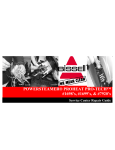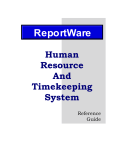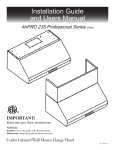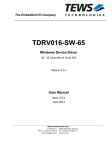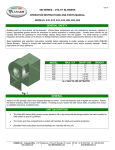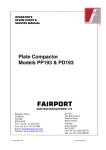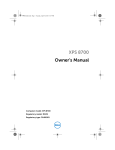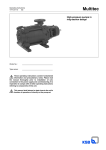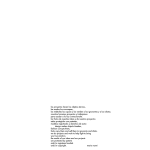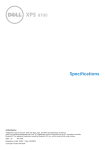Download Service Manual for Industrial V-Belt Drives
Transcript
Service Manual for Industrial V-Belt Drives Power Transmission Products, Inc. U.S.A. Customer Service: (866) 773-2926 CANADA Customer Service: (866) 797-2358 www.carlislebelts.com www.cptbelts.com [email protected] [email protected] 102163 (Rev ©2007) Carlisle Power Transmission Products, Inc. Power Transmission Products, Inc. Carlisle’s Full Power Transmission Line 1 *Power-Wedge® Cog-Belt® (3VX,5VX,8VX) Space saving V-Belt transmits higher HP and gives longer life for maximum savings. 3 Wedge-Band® (R3V,R5V,R8V,R3VX,R5VX,R8VX) Carlisle's Power-Wedge belt in banded design. Eliminates whip and turnover on narrow drives. 4 Wedge-Band® Chipper Drive Belt (R5VL) Specially designed and constructed to meet the unique demands of the forest products industry. Ideally suited for chipper saws, debarker drives, head rigs and hogs. 3 4 5 6 Variable Speed Cog-Belt® (1228V through 6136V Series) Carlisle Variable Speed Cog-Belt offers the same high standard of quality in a replacement belt that Carlisle provides to the OEM. *Super Blue Ribbon® V-Belt (AP,BP,CP,DP) The finest wrapped belt in the industry. 7 *Super II® V- Belt (A,B,C) The revolutionary raw-edge® belt from Carlisle that blows the cover off conventional wrapped belts due to its unique construction. 8 Super Vee-Band ® (RBP,RCP,RDP) Carlisle’s Super Blue Ribbon V-Belt in banded design. Eliminates belt whip and turnover on conventional drives. 9 Gold Ribbon™ Cog-Belt® (AX,BX,CX,DX) The Energy Saver! More efficient than ordinary belts. The finest classical V-belt available. 11 Double-Angle Belt (AA,BB,CC) Designed for use on serpentine type drive applications. 12 Vee-Ribbed™ Belt (J,L,M) Increased HP in 2/3 the space required for normal belts. 13 14 15 17 QD Bushings Standardized for interchangeability. Tapered and fully split through bore length for equivalent of interference fit. 18 Power-Wedge® QD Sheaves (3V,5V,8V) High -capacity cast iron sheaves for use with narrow V-Belts. Standardized QD bushings. 19 V-Ribbed Sheaves (J) For use with V-ribbed belts. Precision form-cut grooves for smooth running. 20 Classical QD Sheaves (AQ,BQ,CQ,DQ) High-Quality heavy duty sheaves for classical (A,B,C,D) V-Belts. 21 Durapower Sheaves-Bushed Type (3L-4L,4L-5L) Cast iron, for all types of light-duty and FHP applications using 3L,4L,5L, A and B V-Belts. Bushing interchanges with similar competitive types. 8 6 Gold Ribbon™ Cog-Band® (RBX,RCX,RDX) A unique combination of our energy saving Cog-Belt and the banded concept. Thoro-Twist® V-Belting (3L,A,B,C,) For use as an emergency replacement where endless V-belts cannot be installed. 2 *Super Power-Wedge® V-Belt (3V, 5V,8V) Designed for lower cost, more compact multiple-belt drives. 10 16 1 2 5 Carlisle’s Full Power Transmission Line (Cont.) 7 9 10 Durapower Sheaves - Fixed Bore Type (3L-4L,4L-5L) Cast iron, bore and keywayed to fit popular shaft sizes. For light-duty. 23 Durapower Sheaves - Adjustable Diameter (3L-4L,4L-5L) Rugged cast iron, two piece threaded assembly allows adjustment of pitch diameter. Combination grooves for use with 3L,4L,5L, A and B section V-Belts. 24 RPP® PANTHER (8M,14M) The ultimate choice in high torque synchronous belt drives. 25 RPP® PANTHER Sprockets Specially designed to handle the high torque transmitted by PANTHER belt drives. 26 RPP PLUS® (3M, 5M, 8M,14M, 20M) Up to 50% more power capacity than conventional high torque drives. 27 Dual RPP® (D8M,D14M) Dual sided synchronous belt with deep tooth parabolic profile teeth allowing synchronous transmission via both the external and internal pulleys in a multi-pulley drive. 28 RPP® Sprockets (5M,8M,14M,20M) Precision companion to RPP and RPP PLUS belts on high torque synchronous drives. 29 Synchro-Cog® Timing Belt (XL,L,H,XH,XXH) For synchronization of driven speed to driver speed. 12 ® Durapower® ll (Raw Edge) FHP Light Duty V-Belt Longer belt life and improved performance. 18 20 19 21 22 23 24 25 13 14 30 XDV® Xtra Duty V-Belt (38X,48X,58X) The XDV belt is designed for tough belt drives; typical of snowblowers, lawn mowers, garden tractors, tillers, etc. Cover fabric design is geared to optimize declutching capability for smooth and reliable transfer of power. 17 22 11 Durapower Light duty V-Belt (3L,4L,5L) Carlisle wrapped belt technology makes Durapower a real heavyweight in the light duty v-belt arena. 16 28 26 Synchro-Cog® Dual Timing Belt (DXL, DL, DH) Provides maintenance-free synchronization from both sides of the belt on positive drive applications. Excellent performance on serpentine type drives. 27 15 31 Synchro-Cog® Timing Pulleys (XL,L,H,XH,XXH) For perfect mating with timing belts on synchronous drives. 29 * available in construction 31 30 Table of Contents This CARLISLE V-BELT DRIVE SERVICE MANUAL has been prepared with the double purpose of: Helping you AVOID V-belt drive problems by presenting a step-by-step V-belt replacement procedure–Section 1: Preventive Maintenance; and helping you SOLVE V-belt drive problems by offering troubleshooting techniques– Section 2: Corrective Maintenance. SUBJECT PAGE V-BELT CONSTRUCTION ............................................................................2 V-BELT DRIVE ADVANTAGES ......................................................................3 SECTION 1–PREVENTIVE MAINTENANCE and INSTALLATION of V-BELT DRIVES ......................................4-9 V-BELT INSTALLATION CHECK LIST ..........................................................9 SECTION 2–CORRECTIVE MAINTENANCE and TROUBLESHOOTING of V-BELT DRIVES ......................10-35 V-BELT DRIVE TROUBLESHOOTING GUIDE ......................................12-13 TROUBLESHOOTING INSTALLATION PROBLEMS ............................14-21 TROUBLESHOOTING SELECTION PROBLEMS ................................22-27 TROUBLESHOOTING ENVIRONMENTAL PROBLEMS ......................28-31 TROUBLESHOOTING DESIGN PROBLEMS ........................................32-35 INSTALLATION AND TAKE-UP DATA ........................................................36 V-BELT TENSION TOOL ........................................................................37-38 V-BELT DEFLECTION FORCE VALUES ....................................................39 TOPICAL INDEX ..........................................................................................40 ! WARNING - SAFETY NOTE Failure to follow recommended application information and recommended procedures for installation, care, maintenance and storage of products may result in failure to perform properly and may result in damage to property and serious bodily injury. Make sure that product selected for any application is recommended for that service. Contact Carlisle or your Carlisle distributor for assistance or specific recommendations. 1 V-Belt Construction Wrapped Belt Raw Edge® Cog-Belt® 1 1 2 2 3 4 4 3 Before we talk about “Avoiding Problems” and “Solving Problems”, let’s take a brief look at how V-belts are constructed. There are basically two types of construction. One has a fabric cover surrounding it; the other–usually rated higher in horsepower–is made in a raw edge, cogged construction. Wrapped Belt Raw Edge® Cog-Belt® 1. Cover–Woven cotton fabric impregnated with neoprene. 1. Tension Section–Specially woven stress-relieved fabric stretches up to 176% more than ordinary bias-cut fabric. 2. Cords–Synthetic Hi-Modulus cords form the strength member to carry high loads with minimum stretching. 3. Compression Section–Exclusive Stiflex® rubber compounds and precision molded cogs increase flexibility while supporting cords evenly. 4. Raw Edge® Sidewalls–Provide uniform, anti-slip surface, greater flexibility and allows more cord width. 2. Tension Section–Synthetic rubber specially compounded to stretch as belt bends around sheaves. 3. Cords–High-strength, synthetic fiber cords carry the horsepower load and minimize stretching. 4. Compression Section–Synthetic rubber compounded to support cords evenly and compress while bending around sheaves. 2 V-Belt Drive Advantages V-belt drives provide many maintenance advantages that help in your daily struggle to reduce equipment repairs and to hold forced downtime to the lowest possible level. 1. They are rugged–they will give years of trouble-free performance when given minimal attention...even under adverse conditions. 2. They are clean–require no lubrication. 3. They are efficient–performing with an average of 93-95% efficiency. 4. They are smooth starting and running. 5. They cover extremely wide horsepower ranges. 6. They permit a wide range of driven speeds, using standard electric motors. 7. They dampen vibration between driving and driven machines. 8. They are quiet. 9. They act as a “safety fuse” in the powertrain. 10. V-belts and sheaves wear gradually– making preventive and corrective maintenance simple and easy. 3 Section 1 Preventive Maintenance and Installation of V-Belt Drives You will notice Reference Key Numbers (such as A -1)appear throughout this section. These refer to a more detailed discussion with illustrations relating to the subject in Section 2 (Corrective Maintenance and Troubleshooting). Safety First Before doing any maintenance work on power drives, be sure the controlling switch is in the OFF position, locked out and tagged. Follow your plant’s safety rules. 4 Preventive Maintenance and Installation of V-Belt Drives Relieve Belt Tension A -1 After removing the drive guard, loosen the drive take-up and move the sheaves closer together to facilitate the removal of all old belts, and to insure installation of the new belts without damage. Inspect Drive Elements A -1 A -6 This is a good time to service the take-up rails by removing any rust and dirt, and lubricating as necessary so tensioning of the new belts will go smoothly and easily. You now also have an excellent opportunity to inspect and replace faulty or damaged machine elements such as worn bearings and bent shafts. This procedure not only reduces the likelihood of future mechanical trouble, but insures maximum service from the new belts you are about to install. Sheaves should be carefully cleaned of any rust and foreign material. A wire brush followed up with a shop cloth will usually do the job. 5 Section 1 Inspect Sheaves A -4 A -9 Sheave condition and alignment are vital to V-belt life and performance. New V-belts should never be installed without a careful and thorough inspection of the sheaves involved. Particular attention should be given to these conditions: a. Worn Groove Sidewalls b. Shiny Sheave Groove Bottom c. Wobbling Sheaves d. Damaged Sheaves Shiny Sheave Groove Bottom Worn Groove Sidewalls Wobbling Sheaves Damaged Sheaves Align Sheaves (Preliminary) A -3 A -5 Alignment should be given preliminary consideration at this time. Check to make sure that: a. The shaft of the DriveR and the DriveN sheaves are parallel, horizontally and vertically. b. The DriveR and DriveN sheaves are in a straight line. c. Both sheaves are properly mounted and as near to the bearings as practical. 6 Preventive Maintenance and Installation of V-Belt Drives Select Replacement Belts B -1 B -4 B -2 B -3 After you have made any necessary corrections in your V-belt drive elements, the next step is the selection of the right replacement belts. In replacing sets of V-belts, here are some Very Important Reminders: • NEVER MIX NEW AND USED BELTS ON A DRIVE. • NEVER MIX BELTS FROM MORE THAN ONE MANUFACTURER. • ALWAYS REPLACE WITH THE RIGHT TYPE OF V-BELT. • ALWAYS OBSERVE V-BELT MATCHING LIMITS. Installing New Belts A -1 Place the new belts on the sheaves, and be sure that the slack of each belt is on the same side. You can do this by pressing the belts with your hand to bring the slack on one side of the drive. Loosening the drive take-up in advance makes this easy. Right Do not force the belts on the sheaves by using a pry bar or by rolling the sheaves. Now, move sheaves apart until the belts are seated in the grooves, and make preliminary tightening of the drive, just until the slack is taken up. Wrong 7 Section 1 Apply Tension A -7 A -8 All V-belt drives must operate under proper tension to produce the wedging action of the belt against the groove sidewall. A well-established rule of thumb is that the best tension for a V-belt drive is the LEAST tension at which the drive will not slip under peak load. Most V-belt problems are due to improper tensioning. Several tools and methods are available to insure proper tensioning. A simple and easy to use option is the Tension-Finder™ available only from Carlisle. Run the drive for about 15 minutes. Then apply full load and check for slipping. Should slipping occur, further tension should be applied. After the drive has operated under load long enough for the belts to become seated and adjusted (approximately 24 hours), it is a good idea to make a final tension inspection. For a complete discussion on tensioning and slippage, refer to Section 2 A -7, in this manual. You have now completed a practical procedure for replacing V-belts that should help you AVOID problems with your V-belt drives. The check list on page 9 serves to summarize the points discussed in this section. Check Sheave Alignment (Final) A -3 One of the advantages of V-belt drives is the fact that perfect alignment of sheaves is not critical to the operation of the drive–V-belts tolerate mis-alignment of up to 1/16 inch per 12 inches of shaft center distance. However, the closer you can come to perfect alignment, the better. Laser Alignment A -3 Use a laser alignment tool or straight edge to check alignment. The straight edge should make contact at four distinct points along the outside perimeter of both sheaves. Contact points Straight edge Refer to Section 2, procedures. Laser alignment tool A -3, for complete discussion of proper alignment Note: Sheaves should always be mounted as close to the bearings as practical to avoid excessive loads on bearings and shafts. 8 Preventive Maintenance and Installation of V-Belt Drives V-Belt Installation Check List ! 1. Cut off and lock out power source. Observe all other safety procedures. ! 2. Remove belt guard. ! 3. Loosen motor mounts. ! 4. Shorten center distance. ! 5. Remove old belts. ! 6. Inspect belt wear patterns for possible troubleshooting. ! 7. Inspect drive elements–bearings, shaft, etc. ! 8. Inspect sheaves for wear and clean. ! 9. Check sheave alignment. (preliminary) ! 10. Select proper replacement belts. ! 11. Install new belts. ! 12. Tension belts. ! 13. Check sheave alignment. (final) ! 14. Replace guard. ! 15. Start drive (look & listen). ! 16. Re-tension after 24 hours. 9 Section 2 Corrective Maintenance and Troubleshooting of V-Belt Drives The first section of this V-Belt Service Manual outlined a step-bystep procedure for the installation of replacement V-belts to help you prevent V-belt maintenance problems. The reason behind these steps is also fundamental in the daily inspection and maintenance of V-belt drives. Watching and listening will alert you to warning signs of trouble, since one of the greatest advantages of V-belt drives is the fact that belts and sheaves wear gradually. You can spot potential problems in time to arrange a short, scheduled maintenance down-time instead of experiencing a longer, costly interruption of production when unexpected trouble occurs. V-belts may be thought of as being much like electrical fuses–their unexpected failure is usually a signal that something else in the system is wrong. Even their patterns of gradual wear can often indicate conditions needing corrections or improvement. 10 Corrective Maintenance and Troubleshooting of V-Belt Drives How to correct maintenance problems by using Carlisle’s Quick Reference Troubleshooting Guide The V-Belt Drive Troubleshooting Guide presented on the following pages represents knowledge acquired by Carlisle in the development and manufacture of V-belts for almost 100 years. This quick-reference guide lists the most common symptoms or warning signs of drive problems and then indicates possible causes. Each possible cause is further referenced by a key number (such as A -1) which indicates where you may find the cure in a more detailed discussion of the subject in this section of the manual. These discussions are grouped into four major sections: A Troubleshooting INSTALLATION Problems B Troubleshooting SELECTION Problems C Troubleshooting ENVIRONMENTAL Problems D Troubleshooting DRIVE DESIGN Problems Practical, non-technical troubleshooting tips are included to help you to quickly identify and correct suspected problems. 11 Worn Cover On Back ❉ Belt Turns Over Or Jumps Off Sheave ● ● ❉ A-5 A-4 Worn Or Damaged Sheaves ● Sheaves Too Far From Bearing A-3 Rapid Sidewall Wear Sheaves Misaligned SYMPTOMS A-2 CAUSES Belts Rubbing Guard CURES Belts Pried On Or Misplaced Slack A-1 Corrective Maintenance and Troubleshooting of V-Belt Drives ● ● Belt Soft, Swollen ❉ Belt Slips, Squeals (Spin Burn) ❉ Belt Cover Split ● Underside Cracked ● Tie-Band Damaged ● ❉ ● Repeated Breakage Belts Ride Too High Belts Bottoming ❉ Repeated Take-up Necessary ● Belts Vibrate Excessively Or Appear Mismatched ● ● Bearings Are Hot ● ● Shafts Whip Or Bend ● ● Cracked Bushings ● Sheave Wobble ● ❉ Indicates most common causes ● Indicates other possible causes 12 ● ● ● ● ● ❉ ● ● ● ● ● ● ❉ ● ❉ ● A-7 A-8 A-9 B-1 B-2 Insufficient Tension Excessive Tension Improper Sheave Installation Belts Worn (Normal Service Life) Wrong Belt Cross-Section Or Type C-2 C-3 C-4 C-5 C-6 C-7 D-1 D-2 D-3 Excessive Heat Excessive Oil Or Grease Use of Belt Dressing Abrasive Environment Foreign Objects In Grooves Excessive Moisture Overloaded Drive/Underbelting Drive Seriously Overbelted Sheaves Too Small ● ● ● ● ● ❉ ❉ ● ● ● ❉ ● ❉ ● ● ● ● ● ● ❉ ❉ ● ● ● ● ● D-5 D-6 Backside Idler Harmonics Insufficient Wrap On Small Sheave D-4 C-1 Machine-Induced Impulse Or Shock B-4 Mismatched Belts Or Mixed Brands B-3 A-6 Poor Bearing Or Shaft Condition Improper Or Prolonged Storage ● ● ● ● ● ● ● ❉ ❉ ❉ ● ● ❉ ● ❉ ❉ 13 Troubleshooting Installation Problems As pointed out in Section 1 of this manual, preventive maintenance by using proper installation techniques is important for long, trouble-free V-belt service. Occasionally, however, you will find it necessary to correct problems caused by improper installation. This section deals with these problems and troubleshooting procedures. 14 Troubleshooting Installation Problems -1 Prying or forcing V-belts onto the sheaves can, and usually does, break some of the load-carrying tensile cords (see photo on page 7, Section 1). When this happens, the belt may either break or turn over in the groove, usually within the first few minutes of operation. This method of installation may be evidenced by a rupture or split in the wrapped cover of the belt, caused by the prying tool or sheave edge. Broken cords are easily identifiable on raw-edge V-belts, because it is usually the edge cords that break first. A Misplaced Slack can also cause belt breakage, again usually on startup. This occurs on multiple-belt drives when all of the belt slack is not brought to the same side of the drive before tensioning. If some belts are tight on one side, and others are tight on the other side, the heavy shock load of starting will be borne by only some of the belts, thus weakening or breaking the load-carrying cords. Ruptured Cover A -2 Belts rubbing against the metal guard or other obstruction will be evidenced by cut or worn fabric on the back or upper edge of the V-belt. Often just replacing missing bolts in guard brackets will remedy this situation. Fabric Worn on Backside 15 A A -3 Misaligned sheaves can cause rapid wear of the V-belt sidewalls, considerably shortening service life of both belts and sheaves. Mis-alignment can also cause separation of the tie-band on banded belts, or apparent mismatching of individual belts. V-belt sheave alignment should be within a tolerance of 1/16” per 12” of drive center distance. The three basic types of sheave and shaft misalignment are shown below, with suggested methods for checking and correcting each type. Note that all 3 types may exist at the same time. Alignment should be checked and corrected in the order given. Sidewall Wear Horizontal Angular 16 Vertical Angular Parallel Troubleshooting Installation Problems 1. Horizontal Angular (shafts in same horizontal plane but not parallel) To Check: Use straightedge or string near sheave centers. To Correct: Loosen motor mounting bolts and rotate motor until all 4 points touch straightedge. 2. Vertical Angular (shafts in same vertical plane but not parallel) To Check: Place straightedge about 4 radius from the outside diameter of both sheaves as shown 1. Repeat on opposite side of shaft 2. Straightedge should touch 4 points indicated in each position. To Correct: Use shims under motor base in front or rear of motor, depending on type of correction required. 3. Parallel (shafts are parallel; sheaves not in line) To Check: Use straightedge or string near sheave centers. To Correct: Loosen sheave so it slides easily on shaft until all 4 points touch straightedge. Retighten sheave in position. Important: Sheave should be mounted as close to bearing as possible to reduce overhung load on bearing. Re-locate equipment if necessary. 17 A -4 Worn or damaged sheaves are an even greater cause of rapid belt wear, slippage and vibration. Badly worn sheaves can cause over-tensioning of the drive to prevent slippage, indirectly causing over-heated bearings and shaft damage. If pieces of the sheave flange are missing, it will result in badly worn sidewalls of the belt, and the resulting sheave imbalance can damage bearings and create a safety hazard. When only some of the grooves are worn more than others, the effect is that the belts appear to be mis-matched. It also causes “differential driving,” where only some of the belts are carrying the entire load of the drive. A In the case of banded belts, worn grooves cause the belts to ride too low in the grooves, thus causing the tie-band to wear against the sheave flanges between the grooves. In severe cases, this can have the same effect as a circular blade, cutting the band and separating the belts. Sheave templates are available from your Carlisle distributor, which can be used to check grooves accurately for wear. A flashlight held behind the template when placed in the groove will help you to observe the amount of wear. “Dishing” should not exceed 1/32” for individual V-belts, or 1/64” for banded V-belts. A shiny groove bottom is a sign that the belt or sheave, or both are badly worn and the belt is bottoming in the groove. Worn sheaves or shiny sheave groove bottoms will show up first on the smaller sheave. The cost of replacing a worn sheave will be more than recovered in longer V-belt life, reduced maintenance and downtime. Worn Sidewalls Proper Position of Belt in Sheave 18 Cut Tie-Band Bottoming and Dishing of Belt in Sheave Troubleshooting Installation Problems -5 Sheaves mounted too far from the bearing cause excessive overhung load on the bearing and overheating. This can also cause shafting to whip, bend or break. Sheaves should be mounted as close as possible to the bearing. If this affects alignment severely, it may be necessary to relocate the equipment to stay within alignment limits of 1/16” per 12” of shaft center-to-center distance. A A -6 Bearing condition and normal wear may well be the cause of overheating, rather than belt tension. They should be inspected for proper lubrication and wear according to the specifications of the bearing or equipment manufacturer. Shaft condition should also be checked and replaced if necessary, as bent shafts can be detrimental to bearings, belts and sheaves, as well as being a safety hazard due to the imbalance created. Sheave “wobble” may be caused by bent shafts. A -7 Insufficient belt tension vies closely with worn sheave grooves as the leading cause of V-belt slippage and other problems. This is often evidenced by “spin burn”. The easiest and most practical way for maintenance personnel to judge proper belt tension is by the “SST” method–Sight, Sound and Touch. Spin Burn 19 A Sight–While the drive is operating, look for a slight “bow” or “sag” in the slack side of the belts. This is normal, and should appear more noticeable under heavy load, such as at startup or during the load cycles of an air compressor, for instance. Check the sheave grooves for wear. Sound–Properly designed V-belt drives should not squeal or howl under peak load conditions, such as on startup of a centrifugal fan. If necessary, stop the drive, then start it again. If a squeal is heard, the belts should be tightened just to the point where they do not squeal under peak load. Newly installed belts require about 24 hours to become fully seated in the grooves, so a little extra tension and a recheck the next day are called for. Touch–V-belts don’t always squeal when they are slipping. If slippage is suspected, a sure way of determining it is by stopping the drive (lock it out!) and placing your bare finger against the inside of a sheave groove. If slippage is present, it will generate enough heat so that you can’t keep you finger on the groove. If this is true, and there is no outside heat source, then the drive is probably slipping. Assuming no sheave wear, the drive should be tightened. If the sheave is worn, replace the sheave and tension normally. Use the various tensioning tools that are available from Carlisle to assure proper tensioning. 20 Troubleshooting Installation Problems -8 Excessive tension on V-belts can be even more detrimental than too little tension, affecting not only the belts, but also bearings and shafts. Again, the best rule is to apply only enough tension on the belts to keep them from slipping during startup or peak loading. Some indicators of excessive tensioning (but not always) are: A • Repeated belt breakage • Excessive vibration • Overheated bearings • Whipping or bent shafts A -9 Improper sheave and bushing installation can result in sheave “wobble” as well as causing bushings or sheave hubs to crack. When installing split-tapered bushings such as QD® or Taper-Lock types, always follow manufacturer’s instructions. It is important to never lubricate the tapered surfaces before installing. The lubrication will permit recommended torque wrench values to increase the actual force on the bushing and hub. This usually results in cracking of the bushings at the bolt hole or keyway. On flanged bushing types, the flange should never be brought up flush with the sheave hub face. A small gap between the two surfaces is normal. When removing split-tapered bushings, start at the jack-screw hole opposite the split, to avoid cracking the bushing. Cracked Bushing Recommened Wrench Torque Values To Use In Tightening QD Bushings Bushing Size QT JA SH-SDS-SD SK SF E F J M N P W S Cap Screw Size & Thread Foot Pounds Torque Wrench Normal Applications* 1/4-1 No. 10-24 1/4-20 5/16-18 3/8-16 1/2-13 9/16-12 5/8-11 3/4-10 7/8-9 1-8 1-1/8-7 1-1/4-7 9 5 9 15 30 60 110 135 225 300 450 600 750 * For severe (rock-crusher type applications) these values can be increased by a maximum of 50%. On severe applications the bolt torque should be rechecked at periodic intervals during operation. 21 B Troubleshooting Selection Problems The array of V-belt types, crosssections and lengths on the market today are all part of technological efforts to provide more efficient, cost-saving answers to your drive requirements. This category is intended to point out how you can be sure of applying the best Carlisle V-belt type to your applications. 22 Troubleshooting Selection Problems B -1 Worn V-belts may have gotten that way simply because they have delivered the service life built into them. Carlisle, like other manufacturers, strives to build V-belts with a “balanced” construction, so each element of the belt will last as long as all other elements. But the wide variety of industrial applications, environmental conditions and maintenance practices makes this impossible to achieve. However, the expected life of an industrial V-belt on a properly designed drive is 3 years. B -2 Using the wrong V-belt cross-section or type can create problems for you...and it’s not hard to do, since many have similar dimensions. For example, the following Carlisle V-belts have approximately the same top width (5/8”) and length (85” O.C.): And yet, the horsepower ratings of these belts range from as little as 2.2 HP per belt to as much as 11.9 HP per belt. on a 5” diameter sheave and 1750 RPM motor! 5/8" 5L 11/32" 5L850 Durapower® Light Duty FHP V-Belt 5/8" 58X 11/32" 58X850 XDV® Premium V-Belt 21/32" BP 7/16" BP82 Super Blue Ribbon® V-Belt 7/16" BX82 Gold Ribbon™ Cog-Belt® 17/32" 5VX850 Power-Wedge® Cog-Belt® 21/32" 5/8" 23 B A V-belt survey of your drives by a Carlisle Certified Drive Specialist can assure you of using the correct V-belt. This service may be obtained by contacting your Carlisle Authorized Stocking Distributor. He maintains a full and convenient inventory of replacement belts and sheaves, and stands ready to assist you in selecting the proper size and type for each application. Carlisle’s Industrial Power Transmission catalog lists all types and sizes of stock industrial belts and sheaves. However, the following suggestions will cover the most serious selection problems: DO match the correct belt cross-section to the sheave groove. (A-A, B-B, 5V-5V, etc.) DON’T use “B” section belts in “5V” grooves, or vice-versa. Check the sheave number stamped on the rim if in doubt. DON’T replace “A” or “B” heavy duty V-belts with “4L” or “5L” light duty (FHP) V-belts. FHP belts are built for Fractional Horsepower applications, and usually run singly. Most multiple drives require heavy duty belts. DO use V-belts marked “Oil and Heat Resistant” where oil or heat is present. The Carlisle Gold Ribbon™ Cog-Belt and Power-Wedge Cog-Belt offer maximum heat and oil resistance–see key numbers C-2 and C-3 DO insist on a belt labeled “Static-dissipating” on drives operating in hazardous atmospheres. DO use banded V-belts where vibration or shock loads can cause belts to turn over or jump out of the sheave grooves. DO use matched sets from the same manufacturer (see key number B -3) DON’T mix old and new belts on a drive. They cannot be matched. GOLD RIBBON™ COG-BELT® GOLD RIBBON™ COG-BELT® OIL HEAT RESISTANT STATIC DISSIPATING OIL HEAT RESISTANT STATIC DISSIPATING MADE IN U.S.A. MADE IN U.S.A. BX62 BX62 B -3 Mismatched belts or mixed brands from different manufacturers cannot be matched together, and will not deliver the service life they should. Although all manufacturers use similar belt numbering systems, different brands with the same number will differ slightly in dimensions and are not capable of being mixed in a set. Also, construction differences cause them to ride differently in the grooves, and to stretch differently. It should be noted that the majority of complaints regarding belt matching are found to be due to other causes, such as misalignment and sheave wear. These factors should always be checked if belts seem to be mismatched. Carlisle belts branded with the Chek-MateTM logo do not require the use of matching codes, but all belts in the set must bear this symbol. 24 Troubleshooting Selection Problems -4 Machine-induced vibration or shock loads frequently can cause V-belts to whip or even jump off the drive, creating a safety hazard, and of course, damaging the belts. B On multiple-belt drives, this whipping can be reduced or eliminated by using banded V-belts. A banded V-belt consists of from 2 to 5 individual V-belts joined together with a bonded, reinforced tie-band (see illustration). These belts will ride slightly higher in the sheave grooves to provide clearance between the band and the sheave flange. Because of this, sheave grooves should not be worn or “dished-out” more than 1/64”. Also, because they are banded together, alignment of the sheaves is somewhat more critical. Belts riding slightly higher in the sheave grooves. (The chart on the next page will be helpful in selecting the best Carlisle belt for an application.) 25 B V-Belt Selection Guide Generic Belt Type (Cross-Sections) Normal HP Range Maximum Belt Speed (FT/Min)(1) Super Blue Ribbon Classical Multiple (A, B, C, D) 1-500 6500 Super ll Classical Multiple (A, B, C, D) 1-500 6500 Gold Ribbon Cog-Belt Classical Cogged Multiple (AX, BX, CX, DX) 1-500 6500 Super Power-Wedge Narrow Multiple (3V, 5V, 8V) 1-1000 6500 Power-Wedge Cog-Belt Narrow Cogged Multiple (3VX, 5VX) 1-600 6500 Classical Banded (RB, RC, RD) 1-500 6500 Gold Ribbon Cog-Band Classical Cogged Banded (Premium HP) (RBX, RCX, RDX) 1-500 6500 Wedge-Band Narrow Banded (R3V, R5V, R8V) 1-1000 6500 Double Angle Double-V Belts (AA, BB, CC, DD) 1-200 6500 Variable Speed (1228V-6136V) 21-100 6500 V-Ribbed (J, L, M) 4-500 6000 Thoro-Twist Link (Segmented) (3LTwist, ATwist, BTwist, CTwist) 1-300 5000 (1000 min.) Durapower FHP (2L, 3L, 4L, 5L) Light Duty 6500 Durapower ll FHP (2L, 3L, 4L, 5L) Light Duty 6500 XDV Premium FHP (38X, 48X, 58X) Light Duty 6500 Carlisle Brand Super Vee-Band Variable Speed Cog-Belt Vee-Rib Notes: (1) Normally limited by sheave materials. (2) Expect little or no life loss due to heat. 26 Troubleshooting Selection Problems Normal Temp. Range (˚F)(2) Oil/Heat Resistance Static Dissipating General Application Min. Max. -35 120 Good ✔ General-Purpose Heavy Duty Industrial Drives. -35 120 Good ✔ General-Purpose Heavy Duty Industrial Drives. -35 130 Excellent ✔ Longer Life, High Efficiency, Small Diameters. -35 130 Very Good ✔ High-Performance, Compact Industrial Drives, Long C.D. -35 130 Excellent ✔ High-Performance, Compact Industrial Drives, Short C.D. -35 120 Good ✔ Reduces Belt Whip, Turnover on Pulsating, Surge Loads. -35 130 Excellent ✔ Longer Life, High Efficiency, Reduces Belt Whip, Turnover on Pulsating, Surge Loads -35 130 Very Good ✔ Reduces Belt Whip, Turnover on Pulsating, Surge Loads -35 120 Good Special Order -35 130 Excellent ✔ Wide-Range Variable Sheaves -35 130 Very Good No Small Diameters, High Speed Ratios, Compact -35 130 Excellent No Emergency Replacement Fixed Center Distance -35 120 Fair ✔ Light Duty Drives Using a Single Belt -35 120 Fair ✔ Light Duty Drives Using a Single Belt -35 130 Very Good No Longer Life on FHP Drives, Clutching Lawn/Garden Drives Available in Serpentine Drives construction 27 C Troubleshooting Environmental Problems “Environmental Protection” can be as important for a V-belt as for humans. This section deals with the effect of adverse environmental conditions on V-belts, and how you can minimize these effects. 28 Troubleshooting Environmental Problems C -1 Improper or prolonged storage can reduce service life considerably. V-belts should be stored in a cool, dry place with no direct sunlight. On shelves in boxes or piles, the stack should be small enough to avoid excess weight and distortion on the bottom belts. On pegs, the longer belts should be coiled in loops of suitable size to prevent distortion from the weight of the belt. The following guide provided by the RMA should be followed for optimum conditions: Guide to Maximum Number of Coilings of V-Belts of Storage Belt Cross Section Belt Length (Inches) Number of Coilings* Number of Loops* A,AA,**3V and B Under 60.0 60.0 to 120.0 120.0 to 180.0 180.0 and up None 1 2 3 1 3 5 7 BB,**C, and 5V Under 75.0 75.0 to 144.0 144.0 to 240.0 240.0 and up None 1 2 3 1 3 5 7 D Under 120.0 120.0 to 240.0 240.0 to 330.0 330.0 to 420.0 420.0 and up None 1 2 3 4 1 3 5 7 9 E and 8V Under 180.0 180.0 to 270.0 270.0 to 390.0 390.0 to 480.0 480.0 and up None 1 2 3 4 1 3 5 7 9 *One coiling results in three loops; two coilings result in five loops, etc. **“AA” and “BB” are known as “double angle” or “hexagonal” V-belts. The pegs should be crescent shaped in cross-section to avoid compression set dents in the belts from sharp corners and the pegs should be sufficiently large in cross-section to avoid compression setting into sharp bends resulting from the weight of the hanging belts. It is recognized that belts are sometimes coiled in smaller loops for packaging for shipment than indicated in the above table, but such packaging should not be for prolonged storage. 29 C C -2 Excessive heat Standard construction V-belts (such as Carlisle’s Super Blue Ribbon) are compounded for moderate resistance, and should give adequate service under normal conditions. Belt temperature (not ambient or surrounding air temperature) is the determining factor when heat is a suspected cause of short belt life. Tests have shown that the service life of a V-belt is cut in half for every 18˚F raise in belt temperature. Troubleshooting Belt Temperature A good general rule for checking belt temperature without sophisticated instruments is to stop the drive (lock it out!) and touch the belt with your hand. If you can grasp if firmly for at least 5 seconds, the belt temperature is probably not over 140˚F and therefore not beyond the operating range for most V-belts. However, if you can’t hold it for at least 5 seconds, the belt temperature is probably well over 140˚F, and heat is contributing to short belt life. Further evidence of heat may be the appearance of small cracks on the underside of the belt. What to do about excessive heat: 1. Check for slippage (see key number A -7). 2. Ventilate the drive or shield from heat source. 3. Replace belts with specially compounded heat-resistant belts (such as Carlisle’s Gold Ribbon or Power-Wedge Cog-Belt). Heat Cracks C -3 Excessive oil or grease Standard construction V-belts (such as Carlisle’s Super Blue Ribbon) are compounded for moderate grease and oil resistance. However, an excessive amount can cause softening, swelling and deterioration of the rubber compounds, as well as slippage. What to do about oil or grease: 1. When there is occasional exposure from spillage or leakage, the belts and sheave grooves should be cleaned with a mixture of detergent and water–after the drive has been locked out and cause of leakage corrected. 2. When belts cannot be protected from oil, specially compounded oilresistant V-belts (such as Carlisle’s Gold Ribbon or Power-Wedge CogBelt) should be used. 30 Troubleshooting Environmental Problems -4 Never apply so-called “belt dressings” to V-belts. These compounds are usually made from a petroleum derivative and can have a destructive effect on rubber compounds and other components of the belt. If belts slip, check for adequate tension and/or worn sheave grooves (see A -4, A -7). C C -5 Abrasive conditions from sand, dust or grit can accelerate wear of both belts and sheaves. This is especially true when slippage is present. Belt selection can be an important factor. Experience has shown that raw-edge constructions reduce this wear because they reduce the “sandpaper-effect” caused by slippage. Drives should be wellshielded against excessive abrasive particles as much as possible. -6 Foreign objects, such as wood chips, can create havoc with V-belt drives. Belt breakage and turnover are the most common symptoms. Shielding the drive is a necessity. Belt guards with expanded metal screening are often used, but ventilation is sometimes sacrificed, possibly requiring additional cooling. Banding belts are often effective, since they eliminate belt turnover. C Abrasive Wear -7 Excessive moisture can penetrate the fabric covering of a V-belt, causing deterioration. In addition, a large amount of water can reduce friction and cause slippage. Belt drives should be protected as much as possible when used outside or when subject to spray from washdown hoses, etc. Belt tension should be inspected regularly. C 31 D Troubleshooting Design Problems When normal corrective measures as discussed in the previous sections do not seem to produce the desired results, an inherent design problem may be the culprit. The solutions to these are best left up to the plant engineering department or a Certified Drive Specialist. However, the discussion presented in this section will help identify symptoms caused by design problems. 32 Troubleshooting Design Problems D -1 Underbelting a drive, (using fewer belts than recommended by good design practice) results in excessive tension in each belt on the drive. This is commonly evidenced by excessive stretching which requires frequent take-ups to prevent slippage. Another warning sign can be repeated belt breakage. In many cases, underbelting can be corrected simply by using raw edge, cogged V-belts which have a higher horsepower rating. When these are used, drives should be identified to assure that future replacements are made with this type of belt. D -2 Drive overbelting, while usually resulting in longer V-belt life, can be just as serious as underbelting. The symptoms most commonly found are overheated bearings and bent shafts. When too many belts are on the drive, the total tension can be excessive when “table” values are used. On the other hand, when too few belts are on the drive, tension values from these tables may be inadequate. D -6 Belt Vibration, is a not-so-common problem resulting from tension harmonics. Since induced vibration can be caused by several factors, this should be referred to plant engineering. 33 D D -3 When sheaves are too small for the belt cross-section, the belt flexes beyond its normal limits. This is usually evidenced by cracks on the underside of the belt. Table A indicates the minimum recommended sheave diameter for flexing each belt cross-section. In most cases, use of a raw-edge cogged belt will improve service life greatly, due to its greater flexibility. Table A. Minimum Recommended Sheave and Idler Diameters V-Belt Cross Section Minimum P.D. Sheave or Inside Idler Minimum O.D. Flat Backside Idler* A, AP 3.0 4.5 B, BP 5.0 7.5 C, CP 9.0 13.5 D, DP 13.0 19.5 E, EP 21.0 31.5 AX 2.6 4.0 BX 4.0 6.0 CX 7.0 10.5 DX 11.0 16.5 3V 2.6 __ 3VX 2.2 __ 5V 7.0 __ 5VX 4.3 __ 8V 12.4 __ 8VX 11.2 __ *Note: Backside Idlers are detrimental to V-belt service life. Another problem caused by sheaves that are too small is overheating of motor bearings, or even bent shafts. NEMA publishes minimum recommended sheave diameters for use with electric motors to avoid excessive bearing loads. Table B shows these minimums for the most common motor types. General purpose motors having continuous time rating with the frame sizes, horsepower and speed ratings listed in the following are designed to operate with V-belt sheaves within the limiting dimensions listed. Selection of V-belt sheave dimensions is made by the V-belt drive vendor and the motor purchaser but, to assure satisfactory motor operation, the selected pitch diameter shall be no smaller than the dimensions listed on the next page. 34 Troubleshooting Design Problems Table B. Application of V-Belt Sheave Dimensions to General Purpose Motors Integral-Horsepower Motors– Polyphase Indcuction Frame Number 3600 143T 145T 182T 182T 184T 184T 184T 213T 215T 215T 254T 254T 256T 256T 284T 284T 286T 324T 326T 364T 364T 365T 365T 404T 404T 404T 405T 405T 405T 444T 444T 444T 444T 445T 445T 445T 445T 12 2-3 3 5 … 5 72 72-10 10 15 15 20 20-25 … … … … … … … … … … … … … … … … … … … … … … … … Horsepower at Synchronous Speed, Rpm 1800 1200 900 1 12-2 3 … … … 5 72 … 10 … 15 … 20 … 25 30 40 50 … 60 … 75 … … 100 … 100 125 … … 125 150 … … 150 200 w 1 12 … 2 … … 3 5 … 72 … 10 … 15 … 20 25 30 40 … 50 … 60 … … 75 … … 100 … … … 125 … … … 2 w 1 … 12 … … 2 3 … 5 … 72 … 10 … 15 20 25 30 … 40 … … 50 … 60 … … … 75 … … … 100 … … Conventional A,B,C,D & E Minimum Pitch Diameter, Inches 2.2 2.4 2.4 2.6 2.4 2.6 3.0 3.0 3.0 3.8 3.8 4.4 4.4 4.6 4.6 5.0 5.4 6.0 6.8 6.8 7.4 8.2 9.0 9.0 9.0 10.0 10.0 10.0 11.5 11.0 10.5 11.0 … 12.5 12.5 … … V-belt Sheave Narrow 3V,5V, & 8V Minimum Outside Diameter, Inches 2.2 2.4 2.4 2.4 2.4 2.4 3.0 3.0 3.0 3.8 3.8 4.4 4.4 4.4 4.4 4.4 5.2 6.0 6.8 6.8 7.4 8.2 8.6 8.0 8.4 8.6 10.0 8.6 10.5 10.0 9.5 9.5 10.5 12.0 12.0 10.5 13.2 NEMA Standard, MG1-14.42 -4 Insufficient wrap on the small sheave can require excessive belt tension to prevent slippage. This condition may require re-design, either using more belts, increasing the center distance or using a backside idler with longer belts. This is again a matter for plant engineering. D -5 Backside idlers can create their own problems, because they cause V-belts to bend opposite to the way they were designed. Care must be taken to see that a backside idler is large enough in diameter to reduce harmful stresses, which often cause cracks on the underside of the belt. Table A (under D -3) also shows these minimum recommended diameters. D Full technical information regarding proper V-belt design can be found in the Carlisle Engineering Guide for Industrial V-Belt Drives available from your Carlisle distributor. 35 INSTALLATION AND TAKE-UP DATA TABLE 3 POWER-WEDGE/SUPER POWER-WEDGE V-BELTS CENTER DISTANCE ALLOWANCE FOR INSTALLATION AND TAKE-UP (INCHES) Standard Length Designation For Take-Up (Add) For Installation (Subtract) 3VX 3V 3V Banded 5VX 5V 5V Banded 250 thru 475 500 thru 710 750 thru 1060 0.5 0.8 0.8 1.2 1.4 1.4 — 1.0 1.0 — 2.1 2.1 1120 thru 1250 1320 thru 1700 1800 thru 2000 0.8 0.8 — 1.4 1.4 — 1.0 1.0 1.0 2120 thru 2360 2500 thru 2650 2800 thru 3000 — — — — — — 3150 thru 3550 3750 4000 thru 5000 — — — — — — 8VX 8V 8V Banded All Cross — — 1.5 — — 3.4 1.0 1.2 1.5 2.1 2. 2.1 1.5 1.5 1.8 3.4 3.4 3.6 1.8 2.2 2.5 1.2 1.2 1.2 2.4 2.4 2.4 1.8 1.8 1.8 3.6 3.6 3.6 3.0 3.2 3.5 1.2 — — 2.4 — — 2.0 2.0 2.0 4.0 4.0 4.0 4.0 4.5 5.5 Sections TABLE 4 CLASSICAL V-BELTS CENTER DISTANCE ALLOWANCE FOR INSTALLATION AND TAKE-UP (INCHES) Standard Length Designation A, AX AP B, BX BP BX & BP Banded 21 thru 35 36 thru 55 56 thru 85 0.75 0.75 0.75 1.00 1.00 1.25 1.50 1.50 1.60 86 thru 112 116 thru 144 148 thru 180 1.00 1.00 — 1.25 1.25 1.25 191 thru 210 225 thru 240 225 thru 300 — — — 315 thru 390 420 and over — — 36 For Take-Up (Add) For Installation (Subtract) C, CX CP CX & CP Banded DX DP DX & DP Banded All Cross Sections — 1.50 1.50 — 2.00 2.00 — — — — — — 1.00 1.50 2.00 1.60 180 1.80 1.50 1.50 2.00 2.00 12.10 2.20 — 2.00 2.00 — 2.90 3.00 2.50 3.00 3.50 1.50 1.50 1.50 1.90 2.00 2.20 2.00 2.00 2.00 2.30 2.50 2.50 2.00 2.50 2.50 3.20 3.20 3.50 4.00 4.50 5.00 — — — — 2.00 2.50 2.70 2.90 2.50 3.00 3.60 4.10 6.00 1.5% of Belt Length Tensioning–Carlisle V-Belt Tension Tool User Instructions The Carlisle Tension-Finder can be used to tension individual belts or V-Bands. The Tension-Finder should be used only with Carlisle belt lines listed in Table 1. The Tension-Finder should NOT be used with aramid cord or glass cord belts. Use with these belts could result in damage to equipment. !Warning!! Remove The Tension-Finder from the belt before starting the drive. Procedure Step 1: Install belts loosely on the drive. Step 2: Apply enough tension to take the slack out of the belts. Step 3: Scribe a line on the belt using the Tension-Finder as a square. (For cog belts see the special instructions) Step 5: With the line in the Start Slot attach the spring to the belt. Note: For cog belts the best place for the spring may be in a cog.(See special instructions) Step 7: Determine the required slot for your drive from Table 1. Tighten the belt until the line has moved to the designated slot. (In this picture the line is in Slot 3.) Step 4: Place the Start Slot over the line. Step 6: Scribe a line at the spring end of the TensionFinder. Use this line as a reference point in case the spring slips off the belt. Step 8: Remove the Tension-Finder from the belt, tighten mounting bolts, and replace belt guards. You’re ready to start the drive! Table 1: Recommended Tensioning Slots Belt Lines AP, BP, CP, DP, RBP, RCP, RDP A, B, C AX, BX. CX, DX, RBX, RCX, RDX 5V,8V R3V, R5V,R8V 5VX, 8VX R3VX, R5VX, Slot No. New Belt Used Belt 2 1 3 2 R5VL SPAX, SPBX, SPCX See recommended slot no’s for table 1 page on (38) 37 Tensioning–Carlisle V-Belt Tension Tool (cont) The recommended slot no's. in Table 1 will provide an adequate level of belt tension on average drives. If more tension is required go to a higher slot no. For less tension go to a lower slot no. Note: Slots 4 and 5 on the Tension-Finder are provided for drives where the values in Table 1 do not provide adequate tension. Please consult Carlisle Application Engineering before tensioning a drive to these slots. !Warning!! Remove The Tension-Finder from the belt before starting the drive. Special Instructions For Cog Belts If the spring clip won’t sit securely on the flat area between cogs take the following steps to scribe the line on the belt. Place the spring in a cog groove. Put a dot at the Start Slot. Be careful not to catch the pen in the slot--you may pull the tip out of the pen. Scribe a line through the dot. The line should extend across the width of the Tension-Finder. Then go back to step 4 on page 37. a. On a single belt drive, depress the Tensiometer until the large “O” ring is even with the bottom of a straight edge placed on the outside rims of the two sheaves. b. On a multiple belt drive, depress the Tensiometer until the large “O” ring is even with the top of the next belt. Measure each belt in the drive. and take the average reading of all belt tensions. 3. Remove the Tensiometer, and observe that the small “O” ring has moved from its original setting at zero to the number of pounds required to deflect the belt. 4. Check this reading against the value of the deflection force in the V-Belt Tensioning table (page 39). 38 Fig. 1 INCHES LARGE "O" RING 1 2. Set the small “O” ring at zero and press down the Carlisle Tensiometer at the center of the belt span (See Fig. 2). 2 1. Measure the span length of the drive. (See Fig. 1). Set the large “O” ring at 1/64˝ for each inch of belt span. For example, set the large “O” ring 1/4˝ for a span length of 16˝, at 1/2˝ for a span length of 32˝, at 1˝ for a span length of 64˝ etc. 10 SMALL "O" RING DEL. Procedure for using the Carlisle V-Belt Tensiometer HOLD HERE 5 Uses a tensioning method based on the fact that the force required to deflect a given span length by a given amount is related to the tension in the belt. 15 20 25 30 LB Spring Loaded Tensiometer for V-Belts PLACE THIS END AT MID-POINT OF BELT SPAN SPAN LENGTH, LS D d DEFLECTION FORCE,p DEFLECTION, q C Fig. 2 Tensioning V-BELT TENSIONING AVERAGE TENSIONING VALUES (RECOMMENDED MINIMUM FORCE PER BELT) V-Belt Type V-Belt Section Super ll A AP B BP Super Blue Ribbon C CP DP AX BX Gold Ribbon Cog Belt CX DX 3VX PowerWedge Cog-Belt 5VX 8VX 5V Super PowerWedge 8V Small Sheave Speed Range Diameter 1800-3600 3.0 1800-3600 4.0 1800-3600 5.0 1800-3600 7.0 1200-1800 4.6 1200-1800 5.0 1200-1800 6.0 1200-1800 8.0 900-1800 7.0 900-1800 9.0 900-1800 12.0 700-1500 16.0 900-1500 12.0 900-1500 15.0 700-1200 18.0 700-1200 22.0 1800-3600 3.0 1800-3600 4.0 1800-3600 5.0 1800-3600 7.0 1200-1800 4.6 1200-1800 5.0 1200-1800 6.0 1200-1800 8.0 900-1800 7.0 900-1800 9.0 900-1800 12.0 700-1500 16.0 900-1500 12.0 900-1500 15.0 700-1200 18.0 700-1200 22.0 1200-3600 2.2 1200-3600 2.5 1200-3600 3.0 1200-3600 4.1 1200-3600 5.3 1200-3600 6.9 1200-3600 4.4 1200-3600 5.2 1200-3600 6.3 1200-3600 7.1 900-1800 9.0 900-1800 14.0 900-1800 12.5 900-1800 14.0 700-1500 17.0 700-1200 21.2 400-1000 24.8 900-1800 7.1 900-1800 9.0 900-1800 14.0 700-1200 21.2 900-1800 12.5 900-1800 14.0 700-1500 17.0 700-1200 21.2 400-1000 24.8 Deflection Force for Drive Speed Ratio (lbs.) 1.00 1.5 2.0 4.0 & over 2.0 2.3 2.4 3.3 2.6 2.8 3.0 3.3 3.0 3.3 3.4 3.7 3.5 3.7 3.8 4.3 3.7 4.3 4.5 5.0 4.1 4.6 4.8 5.6 4.8 5.3 5.5 6.3 5.7 6.2 6.4 7.2 6.5 7.0 8.0 9.0 8.0 9.0 10.0 11.0 10.0 11.0 12.0 13.0 12.0 13.0 13.0 14.0 13.0 15.0 16.0 17.0 16.0 18.0 19.0 21.0 19.0 21.0 22.0 24.0 22.0 23.0 24.0 26.0 2.5 2.8 3.0 3.3 3.3 3.6 3.8 4.2 3.7 4.1 4.3 4.6 4.3 4.6 4.8 5.3 5.2 5.8 6.0 6.9 5.4 6.0 6.3 7.1 6.0 6.4 6.7 7.7 6.6 7.1 7.5 8.2 10.0 11.0 12.0 13.0 11.0 12.0 13.0 14.0 12.0 13.0 13.0 14.0 13.0 14.0 14.0 15.0 16.0 18.0 19.0 20.0 19.0 21.0 22.0 24.0 22.0 24.0 25.0 27.0 25.0 27.0 28.0 30.0 2.2 2.5 2.7 3.0 2.6 2.9 3.1 3.6 3.1 3.5 3.7 4.2 3.9 4.3 4.5 5.1 4.6 4.9 5.1 5.7 5.0 5.4 5.6 6.2 6.5 7.5 8.0 9.0 8.0 9.0 9.5 10.0 9.5 10.0 11.0 12.0 10.0 11.0 12.0 13.0 12.0 13.0 14.0 15.0 14.0 15.0 16.0 17.0 18.0 21.0 23.0 25.0 21.0 23.0 24.0 28.0 24.0 26.0 28.0 30.0 28.0 30.0 32.0 34.0 31.0 32.0 34.0 36.0 8.5 9.5 10.0 11.0 10.0 11.0 12.0 13.0 12.0 13.0 14.0 15.0 14.0 15.0 16.0 17.0 18.0 21.0 23.0 25.0 21.0 23.0 24.0 28.0 24.0 26.0 28.0 30.0 28.0 30.0 32.0 34.0 31.0 32.0 34.0 36.0 NOTE: These are minimum deflection force values. New belts should be installed at two times these values. Used belts should be between 1.0 and 1.5 times these values. 39 Topical Index Topic Pages Topic Pages ABRASION ......................................................31 ALIGNMENT, Sheaves ..............................6,8,16 PITCH DIAMETER ......................................34,35 PRYING BELTS ON DRIVE ..........................7,15 BANDED BELTS................................24,25,26,31 BEARINGS, Overheated ..............18,19,21,33,34 BUSHINGS, Installation of ..............................21 RAW EDGE BELTS (see COGGED V-BELTS) REPLACEMENT CHECKLIST..............................9 RE-TENSIONING ..........................................8,20 CHECKLIST, Belt Installation ............................9 CHEK-MATE ..........................................24,26,27 COGGED V-BELTS ............2,23,24,226,30,33,34 COILING of BELTS ..........................................29 COMPRESSION SECTION of V-BELTS ..............2 CORD, Tensile ..............................................2,15 SAFETY ................................................3,5,20,30 SEATING, V-belt ......................................8,20,24 SELECTION, V-belt ..........................................23 SHEAVE • Alignment ........................................6,8,16 • Bushing ..................................................21 • Cleaning ..................................................5 • Damage ....................................6,18,21,32 • Diameters ..........................................34,35 • Inspection ..............................5,6,16,18,25 • Installation ..................................6,8,16,19 • Wear ..............................................6,18,25 • Wrap ......................................................35 SHIELDS, Drive ....................................15,30,31 SHOCK LOADS ..........................................15,25 SIDEWALLS • Belt ......................................................2,31 • Sheave............................................6,18,31 SIGHT METHOD, Tensioning ..........................20 SLIPPAGE, Causes ............12,18,19,20,30,31,35 SOUND METHOD, Tensioning ........................20 SPLIT-TAPER BUSHINGS................................21 SQUEAL ....................................................12,20 STATIC DISSIPATION ................................24,27 STORAGE ........................................................29 STRETCH ..................................................24,33 DESIGN, Drive Problems ............12,32,33,34,35 DISHING, Sheave Groove (see SHEAVE Wear) DRESSING, Belt ..............................................31 EFFICIENCY ......................................................3 ELEMENTS OF BELT CONSTRUCTION ..............2 ENERGY (see EFFICIENCY) ENVIRONMENTAL CONDITIONS • Abrasion ................................................31 • Foreign objects in drive..........................31 • Heat..............................................24,27,30 • Moisture ................................................31 • Oil & grease ......................................27,30 • Storage ..................................................29 GROOVE, Inspection of ..................5,6,18,24,25 GUARDS, Drive ....................................15,30,31 HEAT, Effect and Measurement of • Ambient ..................................12,24,27,30 • Bearing ..............................12,18,19,34,35 • Belt ....................................................27,30 • Sheave....................................................20 IDLERS, Backside ..........................................35 IMPULSE LOADS ............................................25 INSPECTION • Bearing ..................................................19 • Belt ....................................................12,20 • Shaft ................................................5,6,17 • Sheave ................................5,6,8,16,18,19 INSTALLATION • Belt ................................4,7,9,15,36,37,38 • Bushing ..................................................21 • Sheave....................................6,8,16,19,21 • Tension....................5,9,18,19,33,37,38,39 • Take-Up data ..........................................36 INSUFFICIENT WRAP......................................35 MATCHING, Belt ..........................................7,24 MISALIGNMENT, Sheave ................6,8,16,17,19 MISMATCHING, Apparent ....................16,18,24 MISPLACED SLACK ........................................15 MIXED BRANDS, Use of ..............................7,24 MOISTURE, Excessive ....................................31 MOUNTING, Sheave........................6,8,16,19,21 NEMA, Sheave Standards ..............................35 OIL and GREASE ............................................30 OVERBELTED DRIVE ......................................33 OVERHUNG LOAD ................................19,34,35 OVERLOADED DRIVE......................................33 OVER-TENSIONING ..............................21,33,35 40 TAKE-UP (see TENSION) TEMPERATURE • Ambient........................................24,27,30 • Belt ..............................................24,27,30 • Sheave....................................................20 TEMPLATE, Sheave ........................................18 TENSILE CORDS ..........................................2,15 TENSIOMETER ................................................38 TENSION • Belt ..............8,19,20,21,31,33,35,37,38,39 • Tension-Finder ..................................37,38 TIE-BAND ........................................15,17,25,31 TORQUE WRENCH, Use of..............................21 TOUCH METHOD, to Determine: • Belt Temperature ....................................30 • Slippage ................................................20 • Tension................................................8,20 TROUBLESHOOTING GUIDE ......................12,13 TURNOVER, Belt ..................................15,25,31 UNDERBELTED DRIVE ....................................33 VIBRATION, V-belt ..................3,12,18,21,25,33 V-Belt Tensioning tools ..............................37-38 WOBBLE, Sheave ........................................6,21 WRAP, Insufficient ..........................................35 Carlisle’s Full Power Transmission Line 1 *Power-Wedge® Cog-Belt® (3VX,5VX,8VX) Space saving V-Belt transmits higher HP and gives longer life for maximum savings. 3 Wedge-Band® (R3V,R5V,R8V,R3VX,R5VX,R8VX) Carlisle's Power-Wedge belt in banded design. Eliminates whip and turnover on narrow drives. 4 Wedge-Band® Chipper Drive Belt (R5VL) Specially designed and constructed to meet the unique demands of the forest products industry. Ideally suited for chipper saws, debarker drives, head rigs and hogs. 3 4 5 6 Variable Speed Cog-Belt® (1228V through 6136V Series) Carlisle Variable Speed Cog-Belt offers the same high standard of quality in a replacement belt that Carlisle provides to the OEM. *Super Blue Ribbon® V-Belt (AP,BP,CP,DP) The finest wrapped belt in the industry. 7 *Super II® V- Belt (A,B,C) The revolutionary raw-edge® belt from Carlisle that blows the cover off conventional wrapped belts due to its unique construction. 8 Super Vee-Band ® (RBP,RCP,RDP) Carlisle’s Super Blue Ribbon V-Belt in banded design. Eliminates belt whip and turnover on conventional drives. 9 Gold Ribbon™ Cog-Belt® (AX,BX,CX,DX) The Energy Saver! More efficient than ordinary belts. The finest classical V-belt available. 11 Double-Angle Belt (AA,BB,CC) Designed for use on serpentine type drive applications. 12 Vee-Ribbed™ Belt (J,L,M) Increased HP in 2/3 the space required for normal belts. 13 14 15 17 QD Bushings Standardized for interchangeability. Tapered and fully split through bore length for equivalent of interference fit. 18 Power-Wedge® QD Sheaves (3V,5V,8V) High -capacity cast iron sheaves for use with narrow V-Belts. Standardized QD bushings. 19 V-Ribbed Sheaves (J) For use with V-ribbed belts. Precision form-cut grooves for smooth running. 20 Classical QD Sheaves (AQ,BQ,CQ,DQ) High-Quality heavy duty sheaves for classical (A,B,C,D) V-Belts. 21 Durapower Sheaves-Bushed Type (3L-4L,4L-5L) Cast iron, for all types of light-duty and FHP applications using 3L,4L,5L, A and B V-Belts. Bushing interchanges with similar competitive types. 8 6 Gold Ribbon™ Cog-Band® (RBX,RCX,RDX) A unique combination of our energy saving Cog-Belt and the banded concept. Thoro-Twist® V-Belting (3L,A,B,C,) For use as an emergency replacement where endless V-belts cannot be installed. 2 *Super Power-Wedge® V-Belt (3V, 5V,8V) Designed for lower cost, more compact multiple-belt drives. 10 16 1 2 5 Carlisle’s Full Power Transmission Line (Cont.) 7 9 10 Durapower Sheaves - Fixed Bore Type (3L-4L,4L-5L) Cast iron, bore and keywayed to fit popular shaft sizes. For light-duty. 23 Durapower Sheaves - Adjustable Diameter (3L-4L,4L-5L) Rugged cast iron, two piece threaded assembly allows adjustment of pitch diameter. Combination grooves for use with 3L,4L,5L, A and B section V-Belts. 24 RPP® PANTHER (8M,14M) The ultimate choice in high torque synchronous belt drives. 25 RPP® PANTHER Sprockets Specially designed to handle the high torque transmitted by PANTHER belt drives. 26 RPP PLUS® (3M, 5M, 8M,14M, 20M) Up to 50% more power capacity than conventional high torque drives. 27 Dual RPP® (D8M,D14M) Dual sided synchronous belt with deep tooth parabolic profile teeth allowing synchronous transmission via both the external and internal pulleys in a multi-pulley drive. 28 RPP® Sprockets (5M,8M,14M,20M) Precision companion to RPP and RPP PLUS belts on high torque synchronous drives. 29 Synchro-Cog® Timing Belt (XL,L,H,XH,XXH) For synchronization of driven speed to driver speed. 12 ® Durapower® ll (Raw Edge) FHP Light Duty V-Belt Longer belt life and improved performance. 18 20 19 21 22 23 24 25 13 14 30 XDV® Xtra Duty V-Belt (38X,48X,58X) The XDV belt is designed for tough belt drives; typical of snowblowers, lawn mowers, garden tractors, tillers, etc. Cover fabric design is geared to optimize declutching capability for smooth and reliable transfer of power. 17 22 11 Durapower Light duty V-Belt (3L,4L,5L) Carlisle wrapped belt technology makes Durapower a real heavyweight in the light duty v-belt arena. 16 28 26 Synchro-Cog® Dual Timing Belt (DXL, DL, DH) Provides maintenance-free synchronization from both sides of the belt on positive drive applications. Excellent performance on serpentine type drives. 27 15 31 Synchro-Cog® Timing Pulleys (XL,L,H,XH,XXH) For perfect mating with timing belts on synchronous drives. 29 * available in construction 31 30 Service Manual for Industrial V-Belt Drives Power Transmission Products, Inc. U.S.A. Customer Service: (866) 773-2926 CANADA Customer Service: (866) 797-2358 www.carlislebelts.com www.cptbelts.com [email protected] [email protected] 102163 (Rev ©2007) Carlisle Power Transmission Products, Inc. Power Transmission Products, Inc.













































